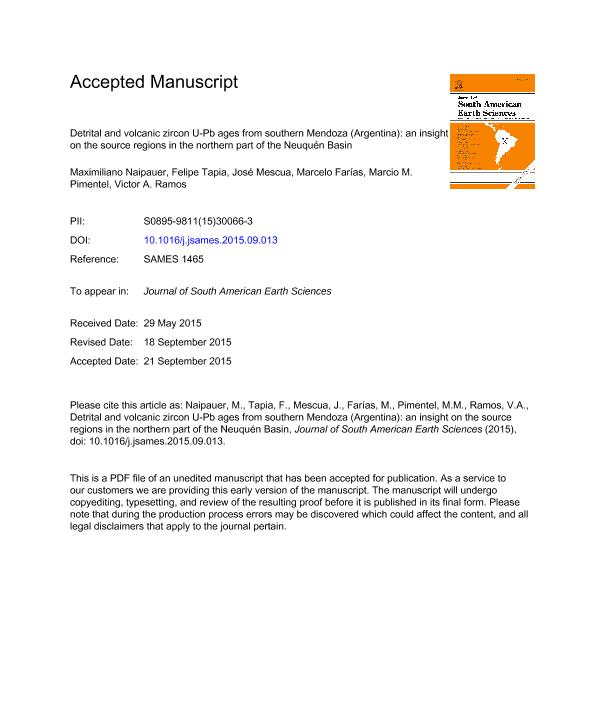Mostrar el registro sencillo del ítem
dc.contributor.author
Naipauer, Maximiliano

dc.contributor.author
Tapia, Felipe

dc.contributor.author
Mescua, Jose Francisco

dc.contributor.author
Farías, Marcelo

dc.contributor.author
Pimentel, Marcio

dc.contributor.author
Ramos, Victor Alberto

dc.date.available
2017-07-14T16:31:16Z
dc.date.issued
2015-10
dc.identifier.citation
Naipauer, Maximiliano; Tapia, Felipe; Mescua, Jose Francisco; Farías, Marcelo; Pimentel, Marcio; et al.; Detrital and volcanic zircon U–Pb ages from southern Mendoza (Argentina): An insight on the source regions in the northern part of the Neuquén Basin; Elsevier; Journal of South American Earth Sciences; 64; 2; 10-2015; 434-451
dc.identifier.issn
0895-9811
dc.identifier.uri
http://hdl.handle.net/11336/20539
dc.description.abstract
The infill of the Neuquén Basin recorded the Meso-Cenozoic geological and tectonic evolution of the southern Central Andes being an excellent site to investigate how the pattern of detrital zircon ages varies trough time. In this work we analyze the U–Pb (LA–MC–ICP–MS) zircon ages from sedimentary and volcanic rocks related to synrift and retroarc stages of the northern part of the Neuquén Basin. These data define the crystallization age of the synrift volcanism at 223 ± 2 Ma (Cerro Negro Andesite) and the maximum depositional age of the original synrift sediments at ca. 204 Ma (El Freno Formation). Two different pulses of rifting could be recognized according to the absolute ages, the oldest developed during the Norian and the younger during the Rhaetian–Sinemurian. The source regions of the El Freno Formation show that the Choiyoi magmatic province was the main source rock of sediment supply. An important amount of detrital zircons with Triassic ages was identified and interpreted as a source area related to the synrift magmatism. The maximum depositional age calculated for the Tordillo Formation in the Atuel-La Valenciana depocenter is at ca. 149 Ma; as well as in other places of the Neuquén Basin, the U–Pb ages calculated in the Late Jurassic Tordillo Formation do not agree with the absolute age of the Kimmeridgian–Tithonian boundary (ca. 152 Ma). The main source region of sediment in the Tordillo Formation was the Andean magmatic arc. Basement regions were also present with age peaks at the Carboniferous, Neoproterozoic, and Mesoproterozoic; these regions were probably located to the east in the San Rafael Block. The pattern of zircon ages summarized for the Late Jurassic Tordillo and Lagunillas formations were interpreted as a record of the magmatic activity during the Triassic and Jurassic in the southern Central Andes. A waning of the magmatism is inferred to have happened during the Triassic. The evident lack of ages observed around ca. 200 Ma suggests cessation of the synrift magmatism. The later increase in magmatic activity during the Early Jurassic is attributed to the onset of Andean subduction, with maximum peaks at ca. 191 and 179 Ma. The trough at ca. 165 Ma and the later increase in the Late Jurassic could be explained by changes in the relative convergence rate in the Andean subduction regime, or by the shift to a more mafic composition of the magmatism with minor zircon fertility.
dc.format
application/pdf
dc.language.iso
eng
dc.publisher
Elsevier

dc.rights
info:eu-repo/semantics/embargoedAccess
dc.rights.uri
https://creativecommons.org/licenses/by-nc-sa/2.5/ar/
dc.subject
Southern Central Andes
dc.subject
Jurassic
dc.subject
Provenance
dc.subject
Andean Basin
dc.subject.classification
Geología

dc.subject.classification
Ciencias de la Tierra y relacionadas con el Medio Ambiente

dc.subject.classification
CIENCIAS NATURALES Y EXACTAS

dc.title
Detrital and volcanic zircon U–Pb ages from southern Mendoza (Argentina): An insight on the source regions in the northern part of the Neuquén Basin
dc.type
info:eu-repo/semantics/article
dc.type
info:ar-repo/semantics/artículo
dc.type
info:eu-repo/semantics/publishedVersion
dc.date.updated
2017-07-13T18:16:01Z
dc.journal.volume
64
dc.journal.number
2
dc.journal.pagination
434-451
dc.journal.pais
Países Bajos

dc.journal.ciudad
Amsterdam
dc.description.fil
Fil: Naipauer, Maximiliano. Consejo Nacional de Investigaciones Científicas y Técnicas. Oficina de Coordinación Administrativa Ciudad Universitaria. Instituto de Estudios Andinos "Don Pablo Groeber". Universidad de Buenos Aires. Facultad de Ciencias Exactas y Naturales. Instituto de Estudios Andinos; Argentina
dc.description.fil
Fil: Tapia, Felipe. Universidad de Chile. Facultad de Ciencias Físicas y Matemáticas. Departamento de Geología; Chile. Consejo Nacional de Investigaciones Científicas y Técnicas; Argentina
dc.description.fil
Fil: Mescua, Jose Francisco. Consejo Nacional de Investigaciones Científicas y Técnicas. Centro Científico Tecnológico Conicet - Mendoza. Instituto Argentino de Nivología, Glaciología y Ciencias Ambientales. Provincia de Mendoza. Instituto Argentino de Nivología, Glaciología y Ciencias Ambientales. Universidad Nacional de Cuyo. Instituto Argentino de Nivología, Glaciología y Ciencias Ambientales; Argentina
dc.description.fil
Fil: Farías, Marcelo. Universidad de Chile. Facultad de Ciencias Físicas y Matemáticas. Departamento de Geología; Chile
dc.description.fil
Fil: Pimentel, Marcio. Universidade Do Brasilia; Brasil
dc.description.fil
Fil: Ramos, Victor Alberto. Consejo Nacional de Investigaciones Científicas y Técnicas. Oficina de Coordinación Administrativa Ciudad Universitaria. Instituto de Estudios Andinos "Don Pablo Groeber". Universidad de Buenos Aires. Facultad de Ciencias Exactas y Naturales. Instituto de Estudios Andinos; Argentina
dc.journal.title
Journal of South American Earth Sciences

dc.rights.embargoDate
2017-11-01
dc.relation.alternativeid
info:eu-repo/semantics/altIdentifier/doi/http://dx.doi.org/10.1016/j.jsames.2015.09.013
dc.relation.alternativeid
info:eu-repo/semantics/altIdentifier/url/http://www.sciencedirect.com/science/article/pii/S0895981115300663
Archivos asociados
